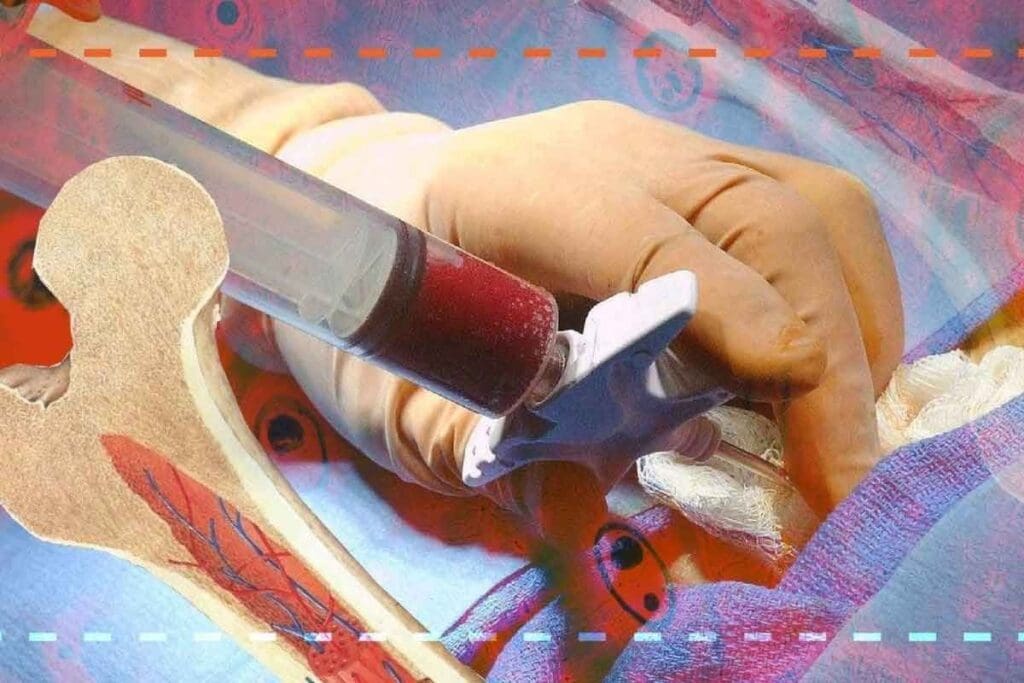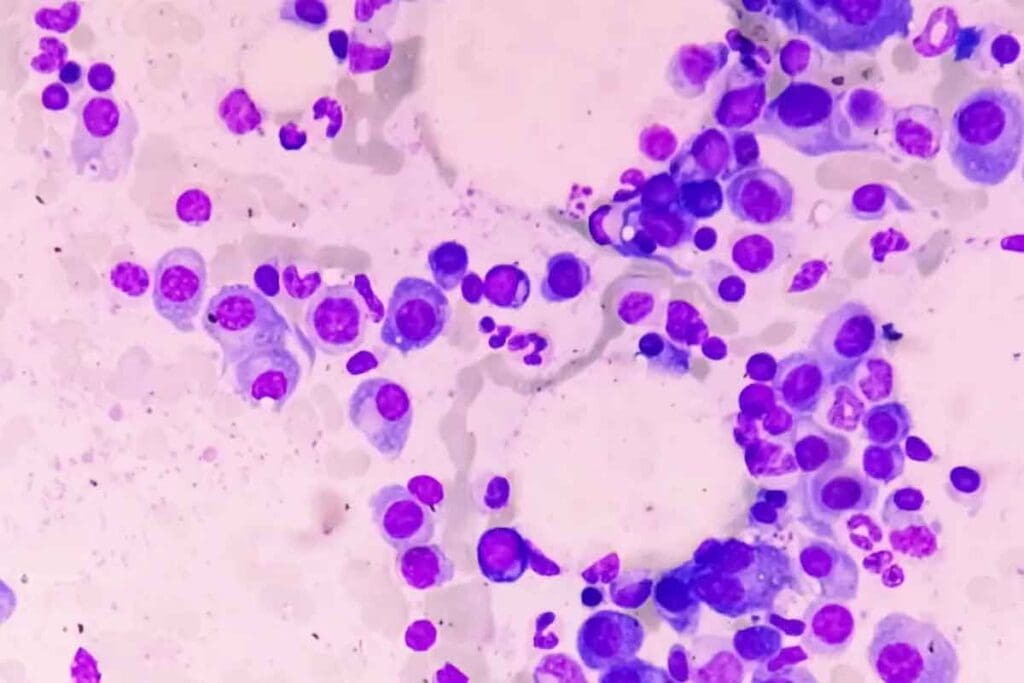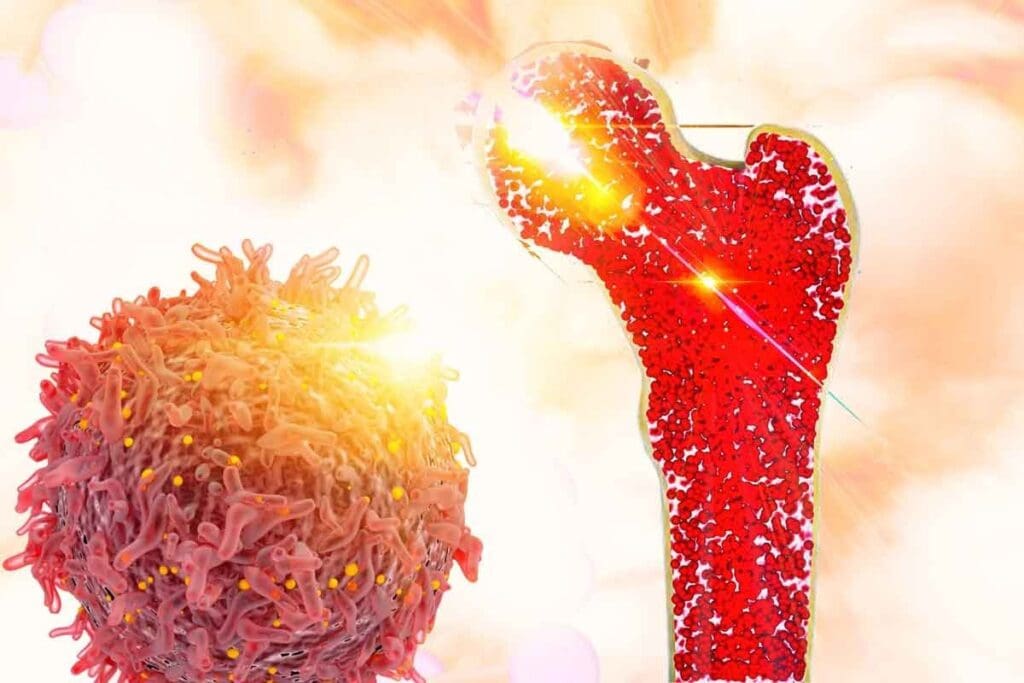Last Updated on November 17, 2025 by Ugurkan Demir

Getting a diagnosis of malignant bone marrow cancer can feel scary. But, with the right help, patients can get through the treatment process.
At LivHospital, we know how critical it is to give full care to those with cancer of the bone marrow symptoms. Our team works together to create treatment plans that fit each patient’s needs.
Bone marrow cancer treatment includes many tests. These include blood tests, bone marrow biopsies, and imaging studies. Treatments might be chemotherapy, targeted therapies, or stem cell transplants.
We will look at the steps for treating malignant bone marrow cancer. We aim to offer a clear and supportive guide for those facing this tough condition.

Bone marrow cancer, also known as malignant neoplasm of the bone marrow, is a group of cancers. They affect the spongy tissue inside bones, where blood cells are made. Knowing about bone marrow cancer is key for good treatment and care.
Bone marrow cancer is when abnormal cells grow too much in the bone marrow. This stops normal blood cell making. It can cause anemia, infections, and bleeding problems. Knowing the exact type of cancer is important for the right treatment.
Studies show bone marrow cancer is linked to genetic changes in blood cells. We’ll look at what causes these changes later.
Bone marrow cancer includes several types of cancers, such as:
Each cancer type has its own traits and needs a special treatment plan.
The exact causes of bone marrow cancer are not known. But, some risk factors have been found. These include:
Knowing these risk factors can help in early detection and prevention. As research goes on, we learn more about the mix of genetic and environmental factors that lead to bone marrow cancer.
As we dive deeper into bone marrow cancer, it’s clear we need a full understanding for good management and treatment. In the next parts, we’ll look at symptoms, diagnosis, and treatment options for bone marrow cancer.

Knowing the signs of bone marrow cancer is key to better treatment. This includes cancers like multiple myeloma and lymphoma. These cancers often show symptoms that can be mistaken for other illnesses.
Bone marrow cancer symptoms vary but include fatigue, weakness, and frequent infections. You might also notice unexplained bruising or bleeding. These signs happen because the cancer disrupts blood cell production.
Common Symptoms:
A hematologist, says early detection is vital. She advises patients to watch for these signs and see a doctor if they don’t go away.
“The key to managing bone marrow cancer is early diagnosis and tailored treatment plans.” –
Oncologist
The type of bone marrow cancer affects symptoms. For example, multiple myeloma causes bone pain and anemia. Lymphoma might lead to swollen lymph nodes and fever.
| Cancer Type | Common Symptoms |
| Multiple Myeloma | Bone pain, anemia, fatigue |
| Lymphoma | Swollen lymph nodes, fever, night sweats |
If you have symptoms that last or are very bad, see a doctor. Early diagnosis is critical for better treatment.
See a healthcare professional if you notice unusual or lasting symptoms. They can check you out and suggest tests to find the cause.
To find out if you have bone marrow cancer, doctors use many tests. They make sure they know exactly what you have and how far it has spread. This helps them choose the best treatment for you.
The first step is initial blood tests. These tests look for signs of bone marrow cancer in your blood. They check for things like anemia or low blood cell counts.
These tests can also find abnormal proteins. These proteins are made by cancer cells in conditions like multiple myeloma. What they find helps doctors decide what to do next.
A bone marrow biopsy is a key test. It takes a sample of bone marrow from your hipbone. This sample is then checked under a microscope.
The biopsy tells doctors about the cancer. It shows what kind of cancer it is and how it affects your bone marrow. Doctors use local anesthesia to make the procedure as painless as possible.
Imaging studies are also important. They use PET scans, MRI, and CT scans to find tumors. These tests show how big the tumors are and if they have spread.
PET scans find cancer cells that are active. MRI gives detailed pictures of soft tissues like bone marrow. These tests help doctors plan your treatment.
Knowing your diagnosis and stage is key. The stage tells you how far the cancer has spread. This information helps you decide on treatment.
| Stage | Description |
| Stage I | Limited disease with low levels of M-protein or few cancer cells. |
| Stage II | Moderate disease with higher levels of M-protein or more cancer cells. |
| Stage III | Advanced disease with high levels of M-protein or extensive cancer cell presence. |
Your healthcare team will explain your diagnosis and stage. They will talk about what it means for your treatment. This information helps you make the best choices for your health.
Treating bone marrow cancer is a detailed process. It needs careful planning and a skilled team. The goal is to create a treatment plan that fits the patient’s needs and health.
The first step is a meeting with a healthcare provider. Here, patients discuss treatment options. They also get a thorough check-up, including a review of their medical history and test results.
We create a treatment plan that’s just right for each patient. This plan might include chemotherapy, targeted therapy, and stem cell transplantation.
Having a good medical team is key. Our team includes experts in bone marrow cancer. They work together to give the best care.
Patients meet a team with:
Many things affect how we treat bone marrow cancer. These include the disease type and stage, the patient’s health, and their personal wishes.
| Factor | Description |
| Type and Stage of Disease | The type and stage of bone marrow cancer determine the most effective treatment approach. |
| Patient’s Overall Health | The patient’s overall health and medical history are considered when developing a treatment plan. |
| Personal Preferences | Patients’ personal preferences and values are taken into account when making treatment decisions. |
The treatment time for bone marrow cancer varies. It depends on the disease type and stage, and how well the patient responds to treatment.
We help patients understand what to expect during treatment. This includes possible side effects and how to handle them.
Bone marrow cancer treatment often starts with chemotherapy and targeted drug treatments. These methods aim to fight the disease well and help patients recover.
Chemotherapy is key in treating bone marrow cancer. Standard chemotherapy protocols use strong drugs to kill cancer cells. The treatment plan depends on the cancer type, stage, and the patient’s health.
We’ll look at common chemotherapy protocols. This includes the drugs used and possible side effects. Knowing this helps patients understand what to expect during treatment.
Targeted therapy is also important. It targets specific molecules in cancer cells, helping to protect normal cells.
We’ll explore the targeted therapy options for bone marrow cancer. We’ll discuss their benefits and possible side effects.
Immunotherapy uses the immune system to fight cancer. It involves drugs that help the immune system find and attack cancer cells.
We’ll talk about immunotherapy for bone marrow cancer. We’ll cover its benefits and challenges.
Managing side effects is vital for quality of life during treatment. Effective side effect management includes medication, lifestyle changes, and supportive care.
We’ll offer tips on handling common side effects. This ensures patients are ready to face treatment challenges.
Stem cell transplantation is a key treatment for bone marrow cancer. It can cure the disease. The process replaces bad stem cells with good ones, from the patient or a donor.
Not every bone marrow cancer patient can get a stem cell transplant. The choice depends on:
A healthcare team must evaluate each patient. They decide if a transplant is right.
There are two main transplant types: autologous and allogeneic. Autologous transplants use the patient’s own stem cells. They are collected, stored, and then given back after chemotherapy. Allogeneic transplants use donor stem cells. They can fight cancer cells better.
Before a transplant, patients must get ready. This includes:
The transplant process is when stem cells are given to the patient. They are put into the bloodstream through a vein. The stem cells go to the bone marrow and start making new blood cells. Patients are watched for any problems, like graft-versus-host disease.
Recovering from a transplant takes a long time. Patients need close care to deal with side effects and prevent infections.
Along with main treatments, supportive care is key in managing bone marrow cancer. These steps help improve comfort, manage symptoms, and boost well-being during and after treatment.
Radiation therapy is a good option for bone marrow cancer, mainly for those with localized disease or needing relief. It uses high-energy rays to kill cancer cells.
A top oncologist says, “Radiation therapy is effective for bone marrow cancer, best when combined with other treatments.”
“Radiation therapy has become more precise, targeting tumors better while protecting healthy tissues.”
| Treatment Type | Application | Benefits |
| External Beam Radiation | Localized disease, palliation | Non-invasive, precise targeting |
| Systemic Radiation | Widespread disease | Targets cancer cells throughout the body |
Steroids are used to reduce inflammation and swelling in bone marrow cancer, like in spinal cord compression. They quickly ease symptoms, improving life quality. But, their use needs careful monitoring for side effects.
Managing pain is key for bone marrow cancer patients to keep their quality of life. This includes medicines and non-medical methods.
Pain management plans are made for each patient, ensuring they get the best care.
Nutrition is critical in bone marrow cancer care. It helps patients handle treatment better and recover faster.
We suggest a diet full of proteins, fruits, and veggies. Nutritional advice helps patients make good food choices.
By adding these extra treatments and care, bone marrow cancer patients can see better results and a better life quality.
New treatments and clinical trials are changing how we fight bone marrow cancer. Researchers are finding new ways to help patients. This means patients now have access to treatments they didn’t have before.
CAR T-cell therapy is a new kind of treatment. It takes T cells from your blood, changes them to fight cancer, and puts them back in. It’s showing great promise in treating blood cancers, including some bone marrow cancers.
Benefits of CAR T-cell therapy include:
Novel targeted agents are drugs that target cancer’s growth and spread. They’re being tested in clinical trials for treating bone marrow cancer better.
A new treatment for myelofibrosis is being tested. It uses a mix of targeted therapies.
Clinical trials test new treatments on patients. Finding and joining these trials can give patients access to new treatments.
To find clinical trials for bone marrow cancer, patients can:
The future of treating bone marrow cancer looks bright. New treatments and trials are being developed. We can expect more effective and personalized treatments as research advances.
| Treatment | Description | Potential Benefits |
| CAR T-cell therapy | Immunotherapy involving modified T cells | Targeted cancer cell killing, long-term remission possible |
| Novel targeted agents | Drugs targeting specific cancer cell molecules | More effective treatment with fewer side effects |
| Clinical trials | Research studies testing new treatments | Access to innovative treatments, contribution to medical research |
The outlook for bone marrow cancer depends on several factors. These include the type and stage of the disease, and how well the patient responds to treatment. Thanks to new treatments, many patients now have a better chance of recovery.
Knowing what to expect and keeping a good quality of life are key. Supportive care helps manage symptoms and side effects. This way, patients can keep living well during treatment.
Whether bone marrow cancer can be cured varies. It depends on the disease type and stage. But, treatments like chemotherapy and stem cell transplants have helped many patients. New treatments like CAR T-cell therapy also bring hope for better outcomes.
Patients can face bone marrow cancer with hope by working with their doctors. Staying updated on new treatments helps. This way, they can aim for the best possible outcome and quality of life.
Bone marrow cancer includes diseases like leukemia and lymphoma. Whether it’s curable depends on the type and stage. We’ll look at treatment options and their success rates.
Symptoms include fatigue, weight loss, and bone pain. Frequent infections are also common. Spotting these signs early is key to treatment.
Doctors use blood tests, bone marrow biopsies, and imaging to diagnose. Knowing the diagnosis helps plan treatment.
Treatments include chemotherapy and targeted therapy. Immunotherapy, stem cell transplants, and radiation are also options. The right treatment depends on the cancer type and stage.
Stem cell transplants can be effective for some cancers. It’s important to understand the transplant process and its types.
Supportive care helps manage pain and side effects. It’s vital for maintaining quality of life during treatment.
Yes, new treatments like CAR T-cell therapy are being tested. These options offer hope for better outcomes.
Look for trials online and talk to your doctor. Clinical trials offer new treatments and help advance cancer care.
The outlook varies based on the disease. Quality of life is maintained through supportive care and staying informed about treatments.
Yes, radiation therapy is used for some cases. It helps manage symptoms and is part of overall care.
Manage side effects with medication and lifestyle changes. Knowing how to handle them is key to a better quality of life.
Subscribe to our e-newsletter to stay informed about the latest innovations in the world of health and exclusive offers!